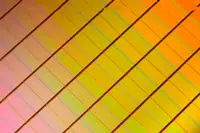 Intel and Micron have produced a memory technology that they claim is up to 1000 times faster than NAND flash. 3D XPoint is the first new class of 'mainstream' memory technology since the introduction of NAND flash in 1989.
Intel and Micron have produced a memory technology that they claim is up to 1000 times faster than NAND flash. 3D XPoint is the first new class of 'mainstream' memory technology since the introduction of NAND flash in 1989.
3D XPoint technology is said to combine the performance, density, power, non-volatility and cost advantages of all available memory technologies on the market today. As well as being faster, Intel and Micron claim the technology also has up to 1000 times greater endurance than NAND, and is 10 times denser than conventional memory.
"One of the most significant hurdles in modern computing is the time it takes the processor to reach data on long-term storage," said Mark Adams, president of Micron. "This new class of non-volatile memory is a revolutionary technology that allows for quick access to enormous data sets and enables entirely new applications."
Following more than a decade of research and development, 3D XPoint was built from the ground up to address the need for non-volatile, high-performance, high-endurance and high-capacity storage and memory at an affordable cost. It is claimed to allow much more data to be stored close to the processor and accessed at speeds previously impossible for non-volatile storage.
Its transistor-less cross point architecture creates a three-dimensional checkerboard where memory cells sit at the intersection of word lines and bit lines, allowing the cells to be addressed individually. As a result, data can be written and read in small sizes, leading to faster and more efficient read/write processes.
Using 3D XPoint, retailers could, for example, more quickly identify fraud detection patterns in financial transactions; healthcare researchers could process and analyse larger data sets in real time, accelerating complex tasks such as genetic analysis and disease tracking.
The performance benefits of 3D XPoint technology could also enhance the PC experience, allowing consumers to enjoy faster interactive social media and collaboration as well as more immersive gaming experiences. The non-volatile nature of the technology also makes it an option for a variety of low-latency storage applications since data is not erased when the device is powered off.
"For decades, the industry has searched for ways to reduce the lag time between the processor and data to allow much faster analysis," said Rob Crooke, senior vice president and general manager of Intel's Non-Volatile Memory Solutions Group. "This new class of non-volatile memory achieves this goal and brings game-changing performance to memory and storage solutions."
Author
Tom Austin-Morgan
Source: www.newelectronics.co.uk
